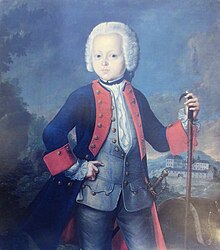Johann Ludwig zu Sayn-Wittgenstein-Hohenstein
Johann Ludwig zu Sayn-Wittgenstein-Hohenstein (born August 3, 1740 at Wittgenstein Castle ; † March 27, 1796 ibid) was a German count from the house of Sayn-Wittgenstein-Hohenstein .
Life
origin
Johann Ludwig was born on August 3, 1740, the eldest son of Count Friedrich zu Sayn-Wittgenstein-Hohenstein (1708–1756) and his first wife, Princess Auguste Albertine Amalie von Nassau-Siegen (1712–1742). His mother was the daughter of Prince Friedrich Wilhelm Adolf zu Nassau-Siegen and Princess Amalie Louise of Courland . Johann Ludwig had an older sister: Louise Friederike Karoline (* March 3, 1739, † May 4, 1788). His half-brother Karl Theodor Wilhelm (born April 27, 1744 Wittgenstein Castle; † November 3, 1817 Stuttgart) comes from the second marriage of his father, who married the younger sister of his late wife, Elisabeth Hedwig (1719–1789) on June 12, 1743 .
Act
When Johann Ludwig's father died, he was only fifteen years old and unable to govern. In his place, Prince Karl August Friedrich von Waldeck initially acted as regent of the County of Wittgenstein . Johann Ludwig started studying at the University of Marburg in May 1756 together with his brother Karl Theodor . Extensive construction work took place during his reign, e.g. B. the renovation of Wittgenstein Castle, the new construction of the rectory in Fischelbach and Weidenhausen as well as the spectacular implementation of a stately building: In 1787, Count Johann Ludwig had the manor house in Ludwigseck built by his father only 34 years earlier demolished and at least used the half-timbered structure for the construction of the new manor house in Schwarzenau, 25 km away . He is said to have been a skilled craftsman and participated in the buildings as a carpenter. “He carried and lifted for two,” wrote the biographer Friedrich Wilhelm Goebel about him in the 19th century. During his reign, Vallendar Castle was also sold to the Archbishopric of Trier for 100,000 Rhenish guilders.
family
Johann Ludwig married his first wife, Friederike Louise Charlotte (born June 9, 1738), daughter of Count Christian Wilhelm Karl von Pückler-Limpurg and Karoline Christiane (née Countess von Löwenstein-Wertheim-Virneburg ) on March 21, 1761 who had a total of nine children:
- Hedwig Christine Louise (1762-1828)
- Auguste Friederike Karoline (1763–1800)
- Caroline (1764-1833)
- Friedrich Karl (1766–1837), (from June 20, 1801 Imperial Prince)
- Friederike Wilhelmine (1767–1849)
- Luise (1768-1828)
- Sophie Karoline (1769-1818)
- Wilhelm Ludwig Georg (1770-1851), (Prussian statesman, became Reichsfürst on June 6, 1804).
The ninth child, a daughter, was not viable, and the mother also died in childbed on July 27, 1772.
Count Johann Ludwig married the sister of his first wife, Wilhelmine Henriette Karoline (August 30, 1746 - March 20, 1800) on November 9, 1772, who bore him four more children:
- Wilhelmine Elise Karoline (1773-1856)
- Friedrich Ludwig Christian (1777–1806)
- Johann Franz Ludwig Karl Ludwig (1779–1815) and
- Adolf Ernst Kornelius Alexander (1783-1856), (on May 11, 1813, he became Prince of Hesse in the Grand Duchy).
Johann Ludwig zu Sayn-Wittgenstein-Hohenstein died at the age of 56 on March 27, 1796 at Wittgenstein Castle.
His eldest son Friedrich Karl zu Sayn-Wittgenstein-Hohenstein was the successor and first prince of the house .
literature
- Family tree of the mediatized house Sayn and Wittgenstein 1907. Unchanged reprint of the 1907 edition, Heimatverlag and Antiquariat Angelika Wied. Bad Laasphe 2009, No. 9/100
- Friedrich Wilhelm Goebel : Historical fragments from the life of the ruling counts and princes zu Sayn-Wittgenstein-Hohenstein , Siegen 1858.
- Ulf Lückel and Andreas Kroh: The Princely House of Sayn-Wittgenstein-Hohenstein. Börde-Verlag, Werl 2004.
Individual evidence
- ↑ Family table of the mediatized house Sayn and Wittgenstein 1907. Plate 10. Unchanged reprint of the 1907 edition, Heimatverlag and Antiquarian Bookshop Angelika Wied. Bad Laasphe 2009, No. 9/100.
- ↑ Ulf Lückel and Andreas Kroh: The Princely House of Sayn-Wittgenstein-Hohenstein. Börde-Verlag, Werl 2004, pp. 19 and 20
- ↑ University of Marburg, registration number 1700–1759, page 327, May 1756, registration number 24: Illustrissimus Dominus Johannes Ludovicus SRI Comes de Sayn, Hohen et Wittgenstein
- ^ Friedrich Wilhelm Goebel: Historical fragments from the life of the ruling counts and princes zu Sayn-Wittgenstein-Hohenstein , Siegen 1858.
- ↑ Ulf Lückel and Andreas Kroh: The Princely House of Sayn-Wittgenstein-Hohenstein. Börde-Verlag, Werl 2004, p. 20.
- ^ Sale of the remaining rights to Vallendar on November 11, 1767 to the Trier Elector Johann Philipp von Waldersdorff, who already owned half of the rule and sovereignty. See also: Konrad Schneider: How Kurtrier paid the rule of Vallendar to Sayn-Wittgenstein . In: Wittgenstein magazine , year 96, March 2008, vol. 72, no. 1, Wittgensteiner Heimatverein, Laasphe 2008.
- ↑ Family table of the mediatized house Sayn and Wittgenstein 1907. Plate 11. Unchanged reprint of the 1907 edition, Heimatverlag and Antiquariat Angelika Wied. Bad Laasphe 2009, No. 9/100.
| personal data | |
|---|---|
| SURNAME | Sayn-Wittgenstein-Hohenstein, Johann Ludwig zu |
| ALTERNATIVE NAMES | Sayn-Wittgenstein, Johann Ludwig zu |
| BRIEF DESCRIPTION | German Count from the House of Sayn-Wittgenstein-Hohenstein |
| DATE OF BIRTH | August 3, 1740 |
| PLACE OF BIRTH | Wittgenstein Castle |
| DATE OF DEATH | March 27, 1796 |
| Place of death | Wittgenstein Castle |
